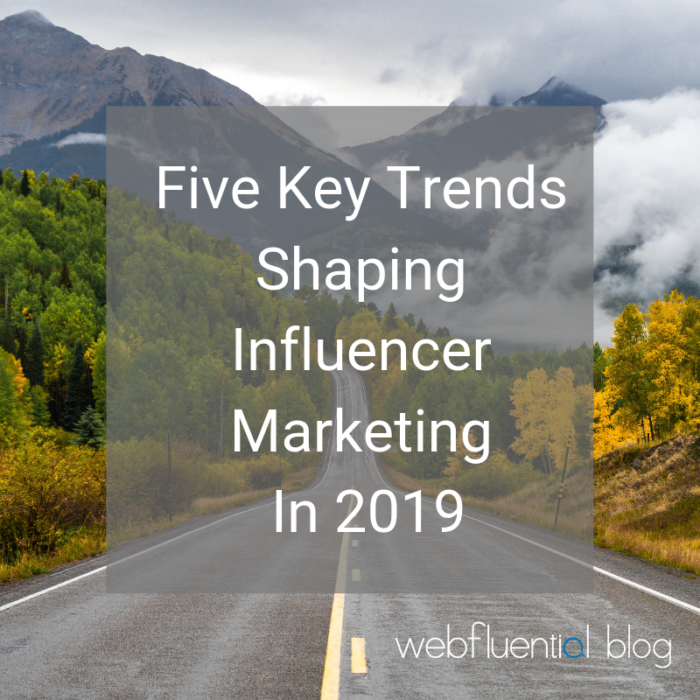March 12, 2019 4:29 pm
Published by Mikyron Padayachee

In 2018 Influencer marketing was more prominent, more scrutinized, and at times more controversial than ever. Privacy transgressions amongst other problems troubled social media platforms. If marketers and influencers want to succeed in 2019 then they will have to take a few factors into account.
Forbes recently wrote an article on the Five Key Trends Shaping Influencer Marketing In 2019. We have summarised the article below and you can see the full article
here.
Instagram rules
In 2018 almost all social media channels faced their own problems. Facebook and YouTube had privacy problems, Twitter had to remove accounts and Snapchat struggled with not only staying relevant but also staying alive. Even with all of this chaos, Influencer marketing has seen significant growth as the number of campaigns using influencers has doubled in the last year.
Instagram has been a part of 93% of all influencer campaigns in the last year. That is more than double the rate than Facebook and Youtube.
Instagram has leveraged the privacy transgressions that have plagued other social media platforms including Facebook. Many Instagram users do not seem to perceive that Instagram misuses collected user data. This, including the fact that Instagram is abundant with beautiful content and has paid attention to its user's needs. This shows why Instagram will continue to be used in many campaigns in 2019.
Just one of the tools
Marketers have become more comfortable with the mechanics of influencer marketing. Marketers are now more sophisticated at integrating influencers into their digital campaigns.
Marketers have realized that their ideas are important, meaning that you can not give an influencer a poor idea and terrible content and expect them to carry the campaign based on their large following. Using influencer’s creativity needs to be seen as an extension to match up with marketer's ideas as an advertiser. Brands can't just hand influencers products and expect them to unauthentically push their audience to buy it. Brands need to look at influencer marketing as ‘creative execution’, leveraging the influencer’s talents and their creative skills to match advertisers ideas or message.
Marketers should consider tying the efforts of influencer’s organic reach to paid media, cross-promotion on other media and other marketing initiatives.
Going Nano
2018 saw the rise of not just the micro influencer, but also the nano influencer. A nano influencer is someone with a few thousand followers operating in a niche market. Fees are less, talent more impressionable and any potential drama more manageable.
While celebrities and macro influencers are still getting booked, the market has shifted. The average number of people following an influencer has halved in the last year to 500 000. This is an indication that the range of influencers being used in campaigns is much broader.
Going Long
Marketers are looking to foster long term relationships with influencers. Influencers also want long term relationships if the brand fits their personal brand and audience.
Long term relationships mean that influencers can put out a consistent message and grow their audience with the brand. More brands have been requesting influencers to co-brand new product lines or be the face of the company and introduce new products.
These deals, while giving influencers more security and continuity can also mean more scrutiny and strings attached. In most cases, these deals are more complicated as the brand can request tight exclusivity terms and rely heavily on the influencer’s authenticity.
Reaching beyond reach
A lot was done in 2018 to deal with influencers using fake followers. Many platforms, like Twitter, spent 2018 removing millions of fake accounts. Brands, such as Unilever, committed to never doing business with people who use fake followers. Data companies have become better at flagging potential fake influencers. Influencers have also been more willing to share their first-party data with marketers so that brands can see engagements.
Marketers are relying much less on reach as a metric. Marketers are relying more on sophisticated metrics such as cost-per-engagement, which can be tied more directly to their return on investment.
Expect the trend on influencer marketing, in general, to become more intertwined in digital campaigns in the next year as influencer marketing platforms and software become more sophisticated.
Get started with booking influencers on Webfluential here.
Register as a Webfluential influencer here.
 In 2018 Influencer marketing was more prominent, more scrutinized, and at times more controversial than ever. Privacy transgressions amongst other problems troubled social media platforms. If marketers and influencers want to succeed in 2019 then they will have to take a few factors into account.
Forbes recently wrote an article on the Five Key Trends Shaping Influencer Marketing In 2019. We have summarised the article below and you can see the full article here.
In 2018 Influencer marketing was more prominent, more scrutinized, and at times more controversial than ever. Privacy transgressions amongst other problems troubled social media platforms. If marketers and influencers want to succeed in 2019 then they will have to take a few factors into account.
Forbes recently wrote an article on the Five Key Trends Shaping Influencer Marketing In 2019. We have summarised the article below and you can see the full article here.


